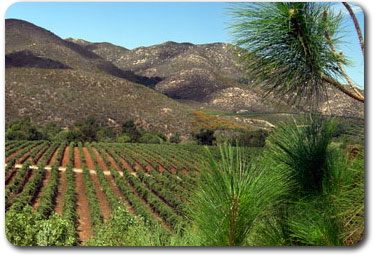 |
|||
 |
|||
|
 |
Dormant Rootings and Dormant Benchgrafts
Dormant Rootings and Dormant Benchgrafts
Plants are usually trimmed at the nursery but may be delivered untrimmed upon request. They will be tied in bundles and come packed in bins or plastic bags, surrounded by moist shavings [or peat moss]. They likely will have been kept in cold storage by the nursery prior to delivery. Upon delivery bundles of vines should be counted to verify the number delivered. Check to be sure that every bundle is properly labeled. It is essential that trimming and inspection be done in a timely manner in a cool location to insure that the plants do not dry out. Vines should be kept moist throughout these operations.
Dormant Vines should also be counted and inspected upon delivery, during trimming or immediately prior to planting. Do not allow the plants to dry out. Cut into a small percentage of the plants to check for wood viability, depth of disbudding wounds, extensive internal discoloration, or other disorders. Trimmed and inspected plants should be repacked and returned to cold storage until planting. Notify the nursery immediately of any problems associated with the vines.
Planting Dormant Vines Plant between mid-March and early June for best results. Remove the vines from cold storage 7-10 days prior to planting. Store them in moist sand or shavings in a cool location away from direct sunlight to allow them to warm up and acclimate to ambient conditions.
Double check the tags to be sure you are planting the correct vines. Re-inspect a few vines for viability by cutting into the scion and rootstock to ensure that no problems occurred during cold storage. Take only a portion of the vines from your storage area to the field for planting unless they can be properly stored there. Do not leave vines in direct sunlight or allow them to dry out. Vines should be carried in buckets with a few inches of water in the bottom to keep the roots wet. If it is sunny and hot, cover the bucket with a wet cloth.
Dig a hole 18-20 inches deep. Place a vine in the hole, position it close to the stake, spread the roots and fill the hole 2/3 full with soil free from any herbicide residues. Raise the vine to the proper height. For benchgrafts, the graft union should be 3-4 inches above the soil line. Rootings should be lifted so that 6 inches are above ground. Tamp soil around the roots and fill the hole. Be certain there are no air pockets around the roots. A newly planted vine should not be easy to pull by hand.
Rootings should be mounded over with loose soil. Benchgrafts may be mounded over or protected with a milk carton or growth tube that is secured with soil. Mounding is recommended as it provides protection from frost, desiccation and other environmental extremes.
If soils are moist, no irrigation is immediately necessary. If irrigating, apply only enough water to wet the root zone and "set" the vines. Do not over irrigate. Emitters should be placed several inches away from the vines so as not to soak the tops of the plants. Do not start regular irrigations until the vines have begun to grow and several new leaves have formed.
Dig near the vines to check soil moisture before starting to irrigate. Do not over water! Do not fertilize until growth has started, and then do so based on the nature of the soil you are farming. In some cases, little or no fertilization may be required the first year.
Care During the First Year Rootings should be irrigated on a regular basis and fertilized as needed to ensure vigorous growth up until the time they are budded. Discontinue irrigation after budding to allow for callus development and healing. Benchgrafts should be irrigated and fertilized in a similar fashion. If plants were mounded over, break down the mounds once the vines are growing and threat of frost is gone. Remove any scion roots that may have formed. Select a strong upright shoot and train it up the stake. In coastal climates, cool with overhead sprinklers (if available) when temperatures are over 100° F.

